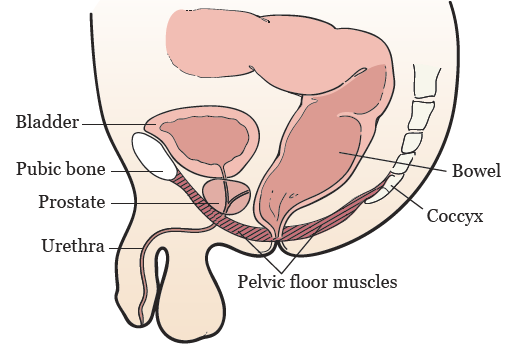This information explains how to do pelvic floor muscle (Kegel) exercises.
About Kegel exercises
The goal of Kegel exercises is to help you strengthen your pelvic floor muscles. These muscles support your bladder and bowel.
Kegel exercises can help you:
- Manage or prevent incontinence. Incontinence is leakage of urine (pee) and stool (poop) that you cannot control.
- Improve your sexual health.
Doing these exercises every day will help strengthen your pelvic floor muscles.
Do not do Kegel exercises while you have a Foley catheter (thin, flexible tube) in place.
About your pelvic floor muscles
Your pelvic floor muscles make up the bottom of your pelvis and support your pelvic organs (see Figure 1). They’re the muscles that relax when you’re urinating (peeing), passing gas, or having a bowel movement (pooping). You also use these muscles to hold in your urine and prevent urine leakage.

Identifying your pelvic floor muscles
The first step in doing Kegel exercises is to identify your pelvic floor muscles. Think of these muscles as the same ones you would use to stop your stream of urine when you’re urinating. Do not do this often because starting and stopping your urine stream every time you urinate can be harmful.
How to do Kegel exercises
Before you start your Kegel exercises, make sure to urinate so your bladder is empty. Remember, do not do Kegel exercises while you have a Foley catheter in place.
When you’re ready, follow these steps:
-
Start by holding your pelvic floor muscles in for 5 seconds. To do this, think of pulling in and lifting up your genitals.
- Do not hold your breath while you do this. Counting out loud can stop you from holding your breath.
- After holding for 5 seconds, slowly and completely relax your muscles for 5 seconds.
- Repeat this process 10 times, at least 3 times every day.
Your pelvic floor muscles may get tired during this exercise. If this happens, stop and do the exercise later.
Do not use your stomach, leg, or buttock muscles when doing this exercise. Exercising these muscles will not help you get back urinary control or improve your sexual health.
As you continue to practice these exercises, increase the time you hold and rest your pelvic floor muscles. Start with 5 seconds, and slowly build up the time each week. Do this until you’re holding in and resting for 10 seconds.
When to do Kegel exercises
Most people prefer doing Kegel exercises while lying down on a bed or sitting in a chair. You can do them in any position you feel comfortable in. Doing Kegel exercises while standing can be very helpful because that’s usually when urinary leakage happens.
To keep your urine from leaking, try to do a Kegel exercise before these activities:
- When standing up.
- Walking.
- Walking to the bathroom.
- Sneezing or coughing.
- Laughing.
Pain and Kegel exercises
Kegel exercises should not hurt. Most people find them relaxing and easy. But if you use the wrong muscles during Kegel exercises, you may feel uncomfortable.
- If you get back or stomach pain after doing Kegel exercises, you may be using your stomach or back muscles instead of your pelvic floor muscles.
- If you get a headache after doing Kegel exercises, you may be making your chest muscles tight and holding your breath.
When to call your healthcare provider
Call your healthcare provider if you:
- Have concerns about your bowel, bladder, or sexual function.
- Are having trouble feeling your pelvic floor muscles.
- Have pain when you do Kegel exercises.
- Have trouble doing Kegel exercises.
- Have pelvic pain.
- Want a referral to a physical therapist who is a specialist in pelvic health.